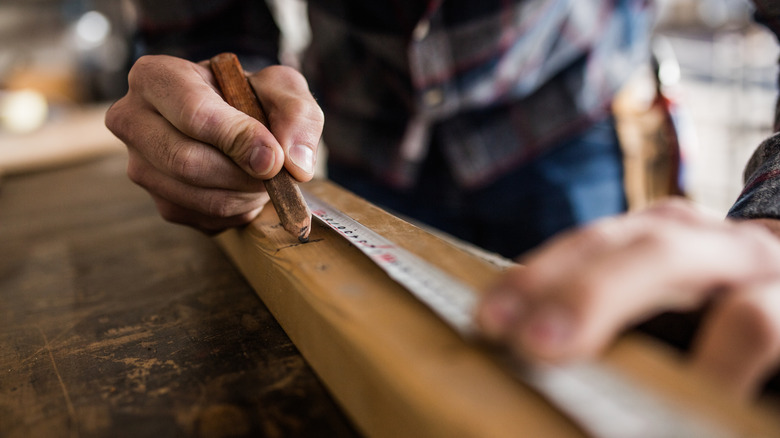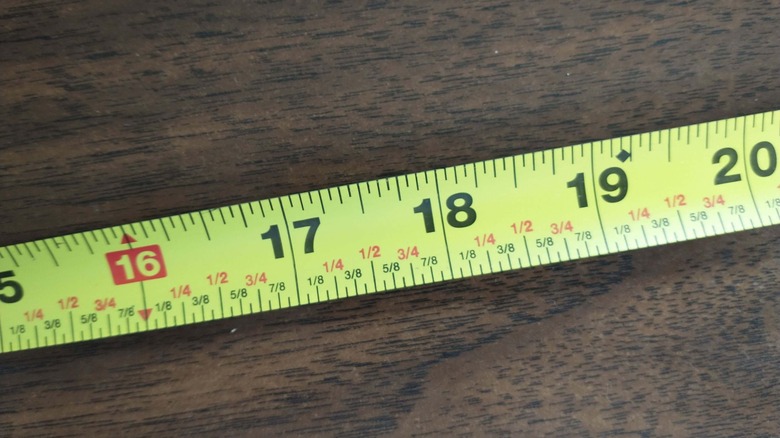What Those Black Diamonds On Tape Measures Really Mean
The two most common questions for DIYers peering at a measuring tape might be, "When is my next optometrist appointment?" and "What are those black diamonds for?" The answer to the first question is, "Better glasses won't help." The second is a little more complicated, but the simple answer is that sometimes house framing members are spaced 19.2 inches apart, so it's handy to have those marks on your tape when laying out a floor or wall during construction.
Carpenters tend to describe such spacing as "19.2 [inches] on center" because it's standard practice to lay boards out so that their centers fall at certain points, in this case, at 19.2 inches. This is described as "on center" or O.C. spacing and it has a few advantages over other approaches like measuring from the edges of boards. One is that nominally identical boards will sometimes have varying dimensions, including thickness. This includes two-by lumber like 2-by-4s, 2-by-6s, etc. If your boards vary in thickness, your layout might get progressively off-kilter, but measuring from the center isn't affected by these differences. Perhaps more importantly, the center is where the coverings for that lumber, such as plywood sheathing or drywall, will begin and end. This is crucial knowledge for any kind of framing and one of the things that you need to know to hang drywall like a pro, and it deserves a bit of a closer look.
Why Mark Joists at 19.2 Inches on center?
People of a certain age will associate "the O.C." with teen television drama, but for everyone else, the O.C. designation eliminates drama. When you're attaching 4-by-8-foot sheet goods to a house, having the edges fall on the center of a board you're attaching it to is critical to make things flow smoothly. For example, attaching sheetrock to the center of a 2-by-4 wall stud, which is 1.5 inches thick, means that you have ¾-inch of the board to screw your sheet into and ¾-inch left over to screw the next sheet into. When you're marking the location of your boards on the wall's top and bottom plates (a process called "layout"), you will use your tape measure to find these center points. It's helpful to have the distances between such centers marked on the tape.
But why 19.2 inches? That seems like a strangely specific but irregular number. The answer is simple: depending on how your studs, joists, or trusses are spaced, you'll need to divide an 8-foot-wide sheet of material evenly so everything lines up. So 19.2 inches is what you get when you have five studs over an eight-foot span. You will occasionally read that the distance is 19 3/16 inches, especially for trusses, but this is incorrect. An 8-foot sheet divided by five is 19.2 inches, not 19.1875 (or 19 3/16) inches.
[Image by Yamfri via Wikimedia Commons | Cropped and scaled | Creative Commons Attribution-Share Alike 4.0 International License]
Other Tape Measure Markings
It's also common to see 24-inch O.C. spacing; your measuring tape already has markings at each two-foot point, usually a large arrow. The most common spacing for walls is 16 inches, and you'll see that your tape measure has markings at multiples of 16 as well. These are usually marked with black or red arrows, which might look like triangles, at 16-inch intervals. The numbers at 16-inch intervals might also be inside a red box, which can help you zero in on the values you're looking for. Spacings larger than 16 inches are becoming common as a material and labor-saving part of advanced framing or "optimum value engineering." Knowing the spacing of your studs can help you find multiple studs in a wall without making holes.
There might be other markings on your measuring tape, depending on its quality, where it was designed to be sold, and the habits of the manufacturer. Most show the number of inches past the last foot mark in red. Some are printed on both sides of the tape, sometimes in a different orientation. Klein, a maker of tools for electricians, makes some tapes with a conduit bending multiplier table printed on it. Some Milwaukee tape measures feature a 12-inch architectural scale, and Lufkin makes a "self-centering" tape that displays distance on one side and the halfway point to that distance on the other, making it easy to find the midway point — for $5 at Home Depot.


